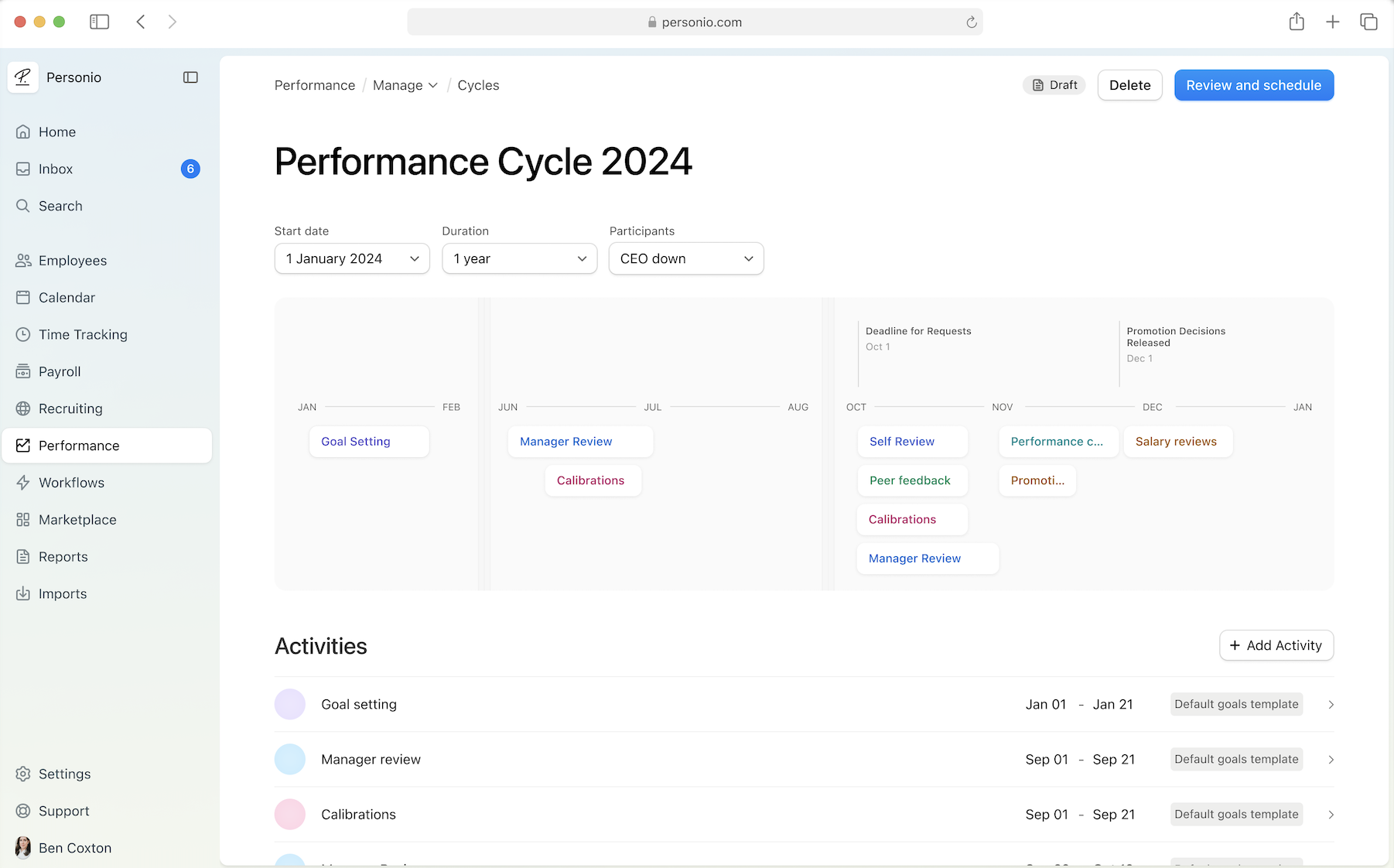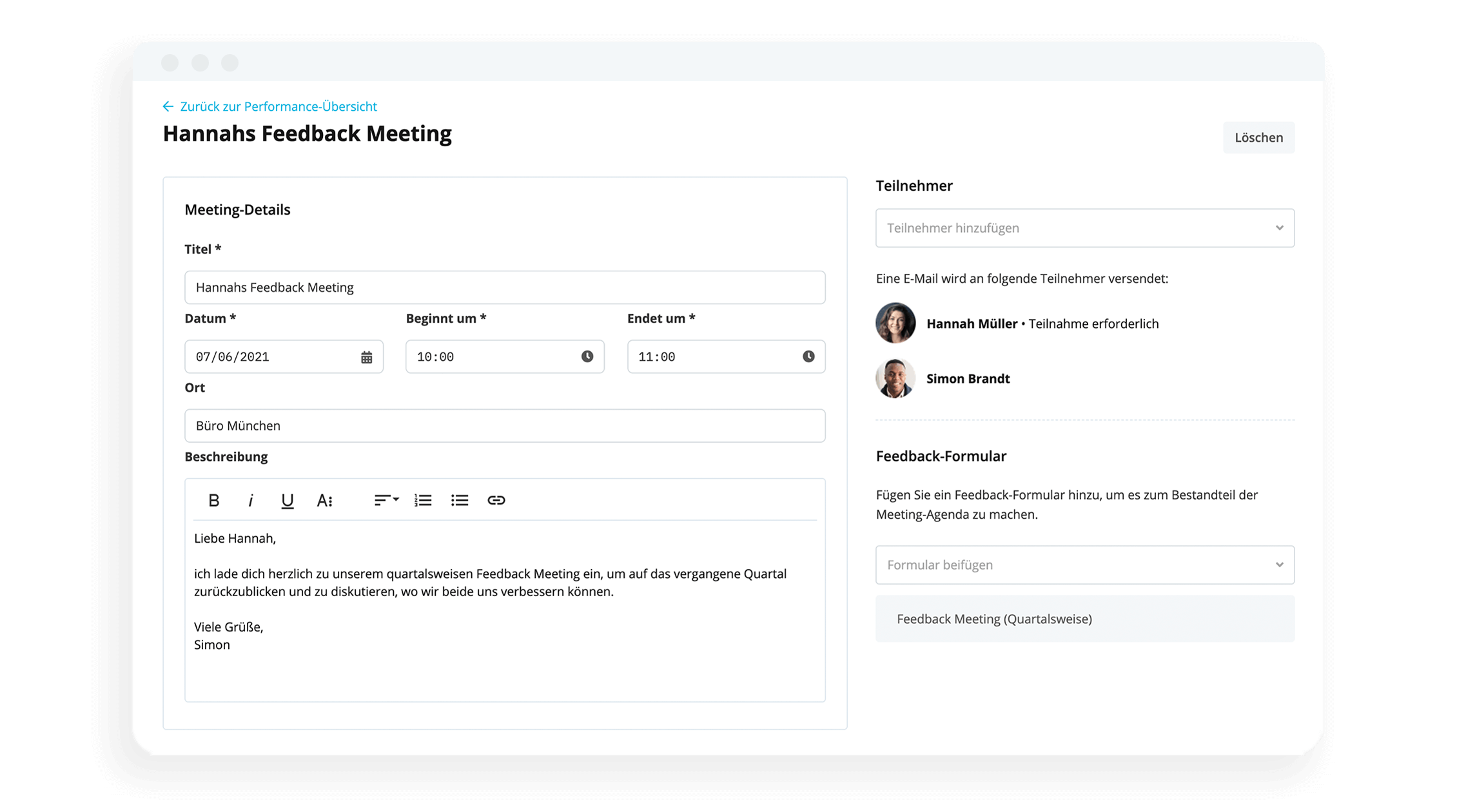
Run better performance appraisals with Personio
Optimise performance processes with customised feedback templates, automated review cycles and goal tracking.
Learn morePerformance appraisal form: Tips & template

Performance appraisals help managers effectively evaluate team members’ strengths and identify opportunities to guide their teams toward achieving strategic goals. To ensure your appraisals are thorough, fair and tailored to drive success, you need a proper performance appraisal form to lay the foundation.
In this article, we explore what a performance appraisal form is and what a well-structured form includes. We also give you a template that you can download and tailor to your process or start using immediately.
What is an employee performance appraisal form?
An employee performance appraisal form is a structured document managers and HR professionals use to assess and record employees’ performance over a defined period.
This form facilitates the evaluation of an individual’s contributions, skills and achievements, providing a basis for feedback and development discussions.
It typically includes sections for work quality, approach to the role, knowledge base, social skills and development potential. This helps managers identify opportunities for growth and improvement, enabling them to align individual performance with broader company objectives.

How to create an employee appraisal form and what to include
A comprehensive employee appraisal form is crucial for facilitating meaningful performance reviews that assess past achievements and set the stage for future growth.
It should be well-structured, include clear performance appraisal objectives and align with your organisation’s goals. This will help employees and managers understand performance standards and expectations, set goals, and provide feedback.
Rating scale
A rating scale provides a standardised measure of performance and behaviours. This scale is usually expressed as numerical values or descriptive qualifiers (for example, ‘exceeds expectations’ or ‘needs improvement’).
Performance appraisal forms often use a five-point scale, with one end for ‘outstanding’ performance and the other for performance that ‘does not meet requirements’. Each point on the scale must be clearly defined to ensure consistency in how managers rate their team members.
When designing a rating scale, ensure that it’s clear, consistent and directly tied to specific performance criteria. This will make it easier to evaluate and compare staff appraisals objectively.

Achievements
The achievements section of the appraisal records an employee’s key accomplishments since their last evaluation. This part of the performance appraisal form enables employees and their supervisors to recognise and reflect on the contributions the employee has made and the impact they have had.
It serves as a reference point for discussing career progression and development opportunities during the appraisal discussion. Documented achievements also provide a tangible basis for considering promotions, salary adjustments and other forms of recognition.
Including detailed achievements in the appraisal form reinforces your employee’s value to the organisation and promotes a culture of recognition and appreciation. By highlighting these successes, you acknowledge their hard work, which can increase morale and motivation.
Employee goals
This section outlines what the employee aims to achieve in the coming period and aligns these objectives with the company’s broader strategic goals.
Clearly defined goals provide a roadmap for the employee, guiding their efforts and priorities over the next review period. This helps to ensure that their daily activities align with the company’s strategic objectives.
Goals should be specific, measurable, achievable, relevant, and time-bound (SMART). This approach ensures that employee’s goals are realistic and manageable within the appraisal cycle, providing clear direction and motivation for them to enhance their performance.
Employee goals encourage skill development and personal growth, which are vital for career advancement and increased job satisfaction. This can include acquiring new competencies, expanding roles within the team, or improving current skills.
Personio’s goal-tracking features can further enhance this process by enabling managers and employees to monitor progress towards these objectives continuously. This ensures that individual efforts are effectively aligned with organisational targets.

Feedback and improvements
This section gathers insights from various sources, encouraging a well-rounded evaluation of the employee’s performance from multiple perspectives. Feedback is pivotal for building a culture of continuous improvement and development within your organisation, while also maintaining open communication between employees and management.
Types of feedback include:
360-degree feedback: Involves collecting feedback from superiors, peers, and subordinates. This method helps you to understand the impact of an employee’s behaviour across the organisation.
Peer feedback: Feedback from colleagues who work closely with the employee, which is valuable for gauging interpersonal skills and teamwork.
Managerial review: Feedback from managers or supervisors focusing on job performance, leadership qualities and goal completion.
Remember: It is essential to keep this feedback confidential. Confidentiality encourages reviewers to be open and honest while helping to prevent conflicts.
The other element in this section is ‘areas for improvement’. This part of the performance appraisal offers constructive criticism and actionable suggestions that support professional development and performance enhancement.
For example, if a peer review suggests difficulty in teamwork, a potential action could be training on collaborative skills or team-building exercises. There should also be realistic timelines for when improvements will be reviewed, providing a clear schedule for reassessment and progress evaluation.
Gathering 360-degree reviews is time-consuming, but you can reduce your workload by setting up automatic performance reviews with Personio.
Managers and employees will receive automatic prompts when it's time for their reviews. You can also create custom, standardised appraisal forms and rating scales to ensure that the feedback is measurable, useful and constructive.

Manager review
A manager review section gives employees an opportunity to evaluate their manager's performance. This feedback is crucial for holding managers accountable for leadership, communication and overall effectiveness in managing their team.
The section enhances organisational transparency by creating a two-way communication channel. Employees are empowered to express their opinions on their manager’s leadership effectiveness, the support they provide, and their management style. This open dialogue helps to address underlying issues that could impact team morale and productivity.
A specific rating rubric ensures the feedback is both focused and constructive. Various managerial aspects, like decision-making, problem-solving and team engagement, must be included on this scorecard. Provide additional space for written comments to allow employees to enrich their feedback with specific examples.
Collecting structured feedback through this rubric helps pinpoint areas where managers can improve, builds leadership development and promotes a culture of continuous improvement within the company.
Streamline performance processes with Personio

Gather feedback, automate review cycles and track important metrics in one single platform.
Find out moreProviding employees with a self-appraisal form
A self-appraisal form, often included as a section of performance review templates, gives individuals an opportunity to assess their own performance and contributions to the organisation over a specific period. In this section, an employee evaluates their strengths and weaknesses in alignment with their job roles and responsibilities
This introspective exercise encourages employees to reflect on their successes, challenges and areas where they see potential for personal and professional growth.
There are many benefits to self-appraisal. First, it promotes self-awareness as the reflective process helps them understand their impact on the team and the broader organisation. This creates a sense of accountability and ownership over their career development.
Self-appraisals also empower employees by giving them a voice in their professional journey. They can highlight their achievements and articulate their perspectives on their performance, which might otherwise be overlooked or undervalued in a traditional, manager-led review. This increases employee morale and engagement, as they feel their contributions are recognised and valued.
Finally, self-appraisals serve as a preparatory step for the performance discussion with their manager. It sets the stage for a more balanced and open dialogue about performance expectations, achievements and development plans.
This collaborative approach to performance management enhances the overall effectiveness of the appraisal process, leading to more accurate assessments and targeted development initiatives.
Appraisal form template
Using a standardised employee appraisal form helps to ensure acceptance, fairness and comparability across all evaluations within your organisation.
This template offers a clear, uniform structure that guides you through the appraisal process, making it easier to assess and compare employee performance effectively and equitably.

Run better employee appraisals with Personio
Running effective staff appraisals is crucial for developing a motivated and high-performing team. These sessions will help you to align employee’s individual goals with your organisation’s objectives.
The right talent management software will help you to track goals, facilitate feedback and automate review cycles. This can be a game-changer for businesses that want to improve employee performance and drive forward organisation-wide goals.
Personio gives you customisable templates, automated workflows and comprehensive feedback systems that enable you to streamline your appraisal process and ensure that reviews are fair, consistent and aligned with your strategic goals.
